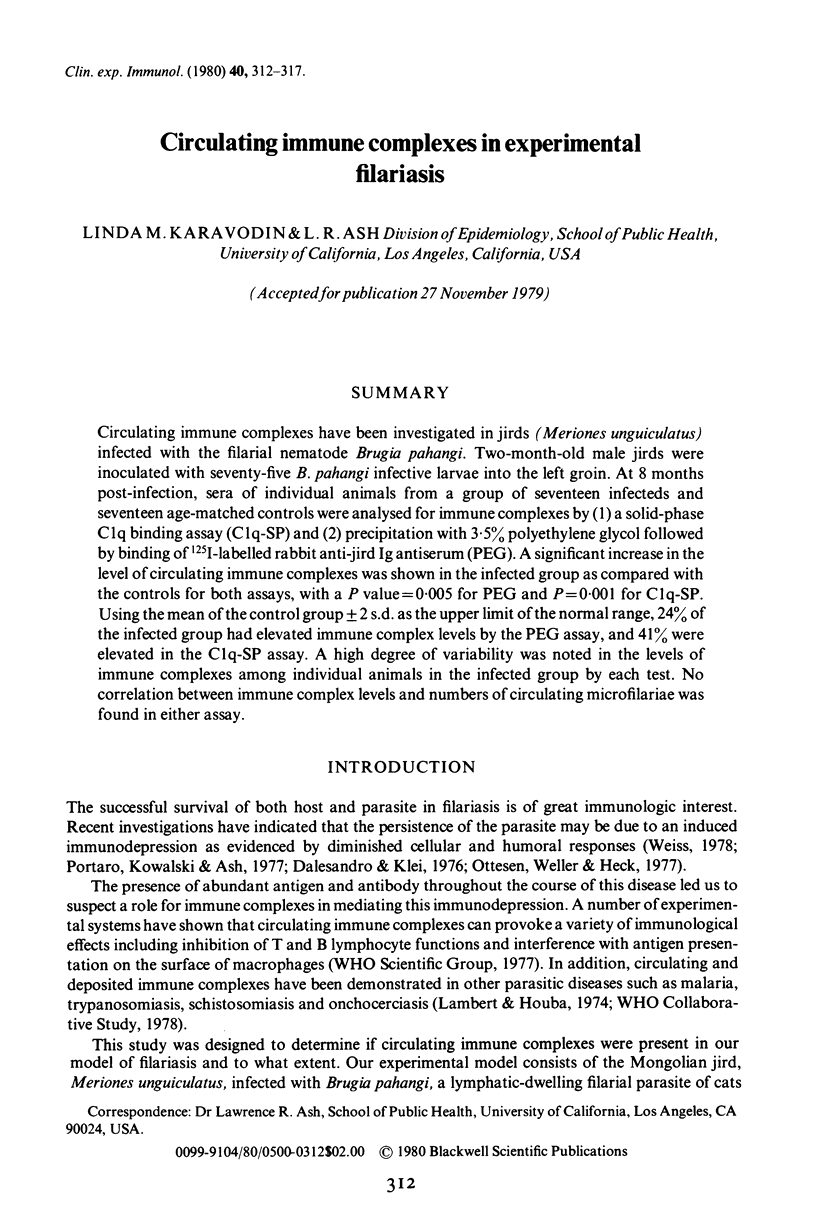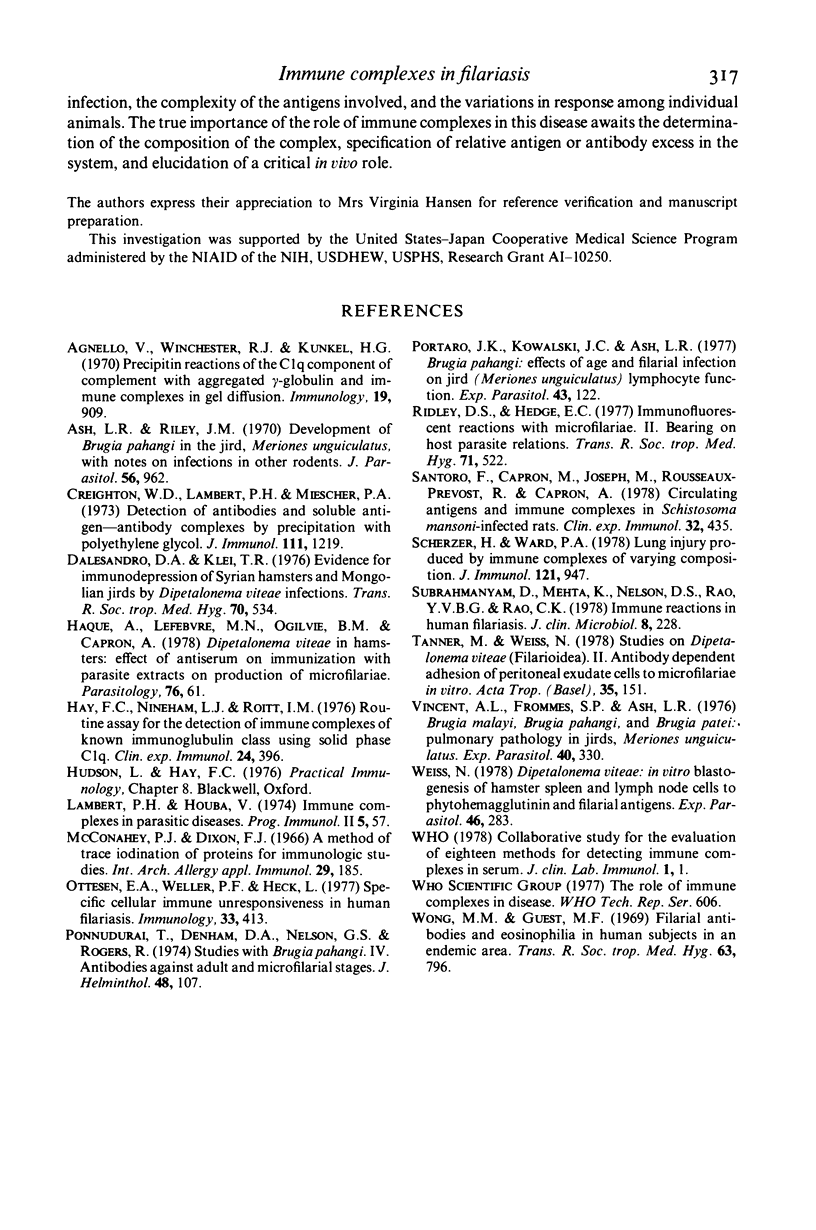Abstract
Circulating immune complexes have been investigated in jirds (Meriones unguiculatus) infected with the filarial nematode Brugia pahangi. Two-month-old male jirds were inoculated with seventy-five B. pahangi infective larvae into the left groin. At 8 months post-infection, sera of individual animals from a group of seventeen infecteds and seventeen age-matched controls were analysed for immune complexes by (1) a solid-phase C1q binding assay (Clq-SP) and (2) precipitation with 3.5% polyethylene glycol followed by binding of 125I-labelled rabbit anti-jird Ig antiserum (PEG). A significant increase in the level of circulating immune complexes was shown in the infected group as compared with the controls for both assays, with a P value = 0.005 for PEG and P = 0.001 for Clq-SP. Using the mean of the control group +/- 2 s.d. as the upper limit of the normal range, 24% of the infected group had elevated immune complex levels by the PEG assay, and 41% were elevated in the C1q-SP assay. A high degree of variability was noted in the levels of immune complexes among individual animals in the infected group by each test. No correlation between immune complex levels and numbers of circulating microfilariae was found in either assay.
Full text
PDF





Selected References
These references are in PubMed. This may not be the complete list of references from this article.
- Agnello V., Winchester R. J., Kunkel H. G. Precipitin reactions of the C1q component of complement with aggregated gamma-globulin and immune complexes in gel diffusion. Immunology. 1970 Dec;19(6):909–919. [PMC free article] [PubMed] [Google Scholar]
- Ash L. R., Riley J. M. Development of Brugia pahangi in the jird, Meriones unguiculatus, with notes on infections in other rodents. J Parasitol. 1970 Oct;56(5):962–968. [PubMed] [Google Scholar]
- Creighton W. D., Lambert P. H., Miescher P. A. Detection of antibodies and soluble antigen-antibody complexes by precipitation with polyethylene glycol. J Immunol. 1973 Oct;111(4):1219–1227. [PubMed] [Google Scholar]
- Dalesandro D. A., Klei T. R. Evidence for immunodepression of Syrian hamsters and Mongolian jirds by Dipetalonema viteae infections. Trans R Soc Trop Med Hyg. 1976;70(5-6):534–535. doi: 10.1016/0035-9203(76)90152-8. [DOI] [PubMed] [Google Scholar]
- Haque A., Lefebvre M. N., Ogilvie B. M., Capron A. Dipetalonema viteae in hamsters: effect of antiserum or immunization with parasite extracts on production of microfilariae. Parasitology. 1978 Feb;76(1):61–75. doi: 10.1017/s0031182000047399. [DOI] [PubMed] [Google Scholar]
- Hay F. C., Nineham L. J., Roitt I. M. Routine assay for the detection of immune complexes of known immunoglobulin class using solid phase C1q. Clin Exp Immunol. 1976 Jun;24(3):396–400. [PMC free article] [PubMed] [Google Scholar]
- McConahey P. J., Dixon F. J. A method of trace iodination of proteins for immunologic studies. Int Arch Allergy Appl Immunol. 1966;29(2):185–189. doi: 10.1159/000229699. [DOI] [PubMed] [Google Scholar]
- Ottesen E. A., Weller P. F., Heck L. Specific cellular immune unresponsiveness in human filariasis. Immunology. 1977 Sep;33(3):413–421. [PMC free article] [PubMed] [Google Scholar]
- Ponnudurai T., Denham D. A., Nelson G. S., Rogers R. Studies with Brugia pahangi. 4. Antibodies against adult and microfilarial stages. J Helminthol. 1974 Jun;48(2):107–117. doi: 10.1017/s0022149x00022677. [DOI] [PubMed] [Google Scholar]
- Portaro J. K., Kowalski J. C., Ash L. R. Brugia pahangi: effects of age and filarial infection on jird (Meriones unguiculatus) lymphocyte function. Exp Parasitol. 1977 Oct;43(1):122–127. doi: 10.1016/0014-4894(77)90015-7. [DOI] [PubMed] [Google Scholar]
- Ridley D. S., Hedge E. C. Immunofluorescent reactions with microfilariae. 2. Bearing on host-parasite relations. Trans R Soc Trop Med Hyg. 1977;71(6):522–525. doi: 10.1016/0035-9203(77)90148-1. [DOI] [PubMed] [Google Scholar]
- Santoro F., Capron M., Joseph M., Rousseaux-Prevost R., Capron A. Circulating antigens and immune complexes in Schistosoma mansoni-infected rats. Characterization by radioimmunoprecipitation-PEG assay (RIPEGA). Clin Exp Immunol. 1978 Jun;32(3):435–442. [PMC free article] [PubMed] [Google Scholar]
- Scherzer H., Ward P. A. Lung injury produced by immune complexes of varying composition. J Immunol. 1978 Sep;121(3):947–952. [PubMed] [Google Scholar]
- Subrahmanyam D., Mehta K., Nelson D. S., Rao Y. V., Rao C. K. Immune reactions in human filariasis. J Clin Microbiol. 1978 Aug;8(2):228–232. doi: 10.1128/jcm.8.2.228-232.1978. [DOI] [PMC free article] [PubMed] [Google Scholar]
- Tanner M., Weiss N. Studies on Dipetalonema vitae (Filarioidea). II. Antibody dependent adhesion of peritoneal exudate cells to microfilariae in vitro. Acta Trop. 1978 Jun;35(2):151–160. [PubMed] [Google Scholar]
- Vincent A. L., Frommes S. P., Ash L. R. Brugia malayi, Brugia pahangi, and Brugia patei: pulmonary pathology in jirds, Meriones unguiculatus. Exp Parasitol. 1976 Dec;40(3):330–354. doi: 10.1016/0014-4894(76)90100-4. [DOI] [PubMed] [Google Scholar]
- Weiss N. Dipetalonema viteae: in vitro blastogenesis of hamster spleen and lymph node cells to phytohemagglutinin and filarial antigens. Exp Parasitol. 1978 Dec;46(2):283–299. doi: 10.1016/0014-4894(78)90142-x. [DOI] [PubMed] [Google Scholar]
- Wong M. M., Guest M. F. Filarial antibodies and eosinophilia in human subjects in an endemic area. Trans R Soc Trop Med Hyg. 1969;63(6):796–800. doi: 10.1016/0035-9203(69)90123-0. [DOI] [PubMed] [Google Scholar]


